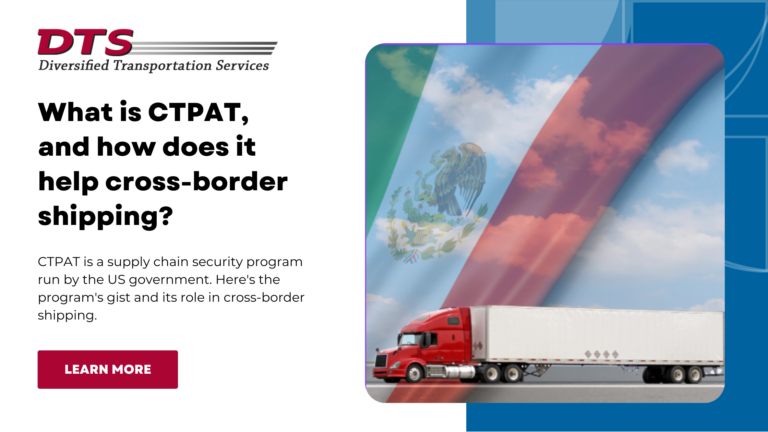
Sending cargo across borders, either between the US and Mexico or further afield, can be a complex process. Understanding the latest customs programs and requirements can help you navigate cross-border shipping more easily and help ensure you comply with all relevant regulations.
Keeping cargo safe while in transit is essential for avoiding expensive delays and frustrated clients. The C-TPAT program plays a key role in securing cargo during cross-border shipping and offers several other valuable benefits.
In this post, we’ll explore the C-TPAT program, who is eligible to use it, and some of its benefits.
The Customs-Trade Partnership Against Terrorism (CTPAT) is a voluntary supply-chain security program run by US Customs and Border Protection (CBP).
CTPAT was introduced in November 2001, following the September 11th terrorist attacks in New York City, to improve the security of private companies’ supply chains. The goal of CTPAT is to prevent supply chains from being compromised by terrorist organizations or other bad actors.
According to CBP, more than 11,400 certified partners have become involved with the program. Any entities that join CTPAT agree to work with CBP to pinpoint security vulnerabilities, help protect the supply chain, and utilize the required security measures. Members of CTPAT are considered low-risk and are less likely to undergo examination at any US port of entry.
A wide range of businesses are eligible to become CTPAT members, primarily those that import goods into the US. These include:
Any 3PLs that want to become members of the program and achieve CTPAT certification must be licensed and/or bonded by:
They must also have a staffed office within the US.
Additionally, CBP has opened the C-TPAT program up to US exporters as part of the National Export Initiative (NEI). The NEI was formally launched in 2010 to help small businesses and farmers increase exports. To be eligible, active US exporters must meet specific criteria, including holding a documentable Employee Identification Number (EIN)/Dun & Bradstreet (DUNS) number.
Companies that want to apply for CTPAT certification may do so through CBP. Joining the CTPAT program is free. The application process involves multiple steps.
The first is to review your entity's C-TPAT Minimum Security Criteria to determine whether you’re eligible to join. Basic applications should be submitted through the C-TPAT Portal system. You will be required to conduct your own risk assessment (sometimes referred to as a “CTPAT audit”) and security profile, explaining how you meet the Minimum Security Criteria.
Two of the primary benefits of C-TPAT include increasing supply chain visibility and helping CBP apply resources to high-risk shipments more effectively.
However, achieving C-TPAT certification also offers a number of benefits to US businesses. These include:
Though the CTPAT program has many moving parts and requirements, it can help speed up operations for companies involved in cross-border shipping. Key benefits include shorter wait times to cross all covered borders and access to FAST lanes, making navigating the application process worthwhile.
Dealing with the intricacies of cross-border shipping can be confusing, so it’s essential to stay informed about different customs requirements and programs to help you prepare. On our blog, we cover all sorts of cross-border freight topics. Browse our comprehensive range of cross-border shipping blog posts or get in touch with the DTS team for shipping help and advice.
Whether you're a company looking to improve one facet of your supply chain, your entire supply chain, or simply looking for a transportation and logistics consultation, we can help.